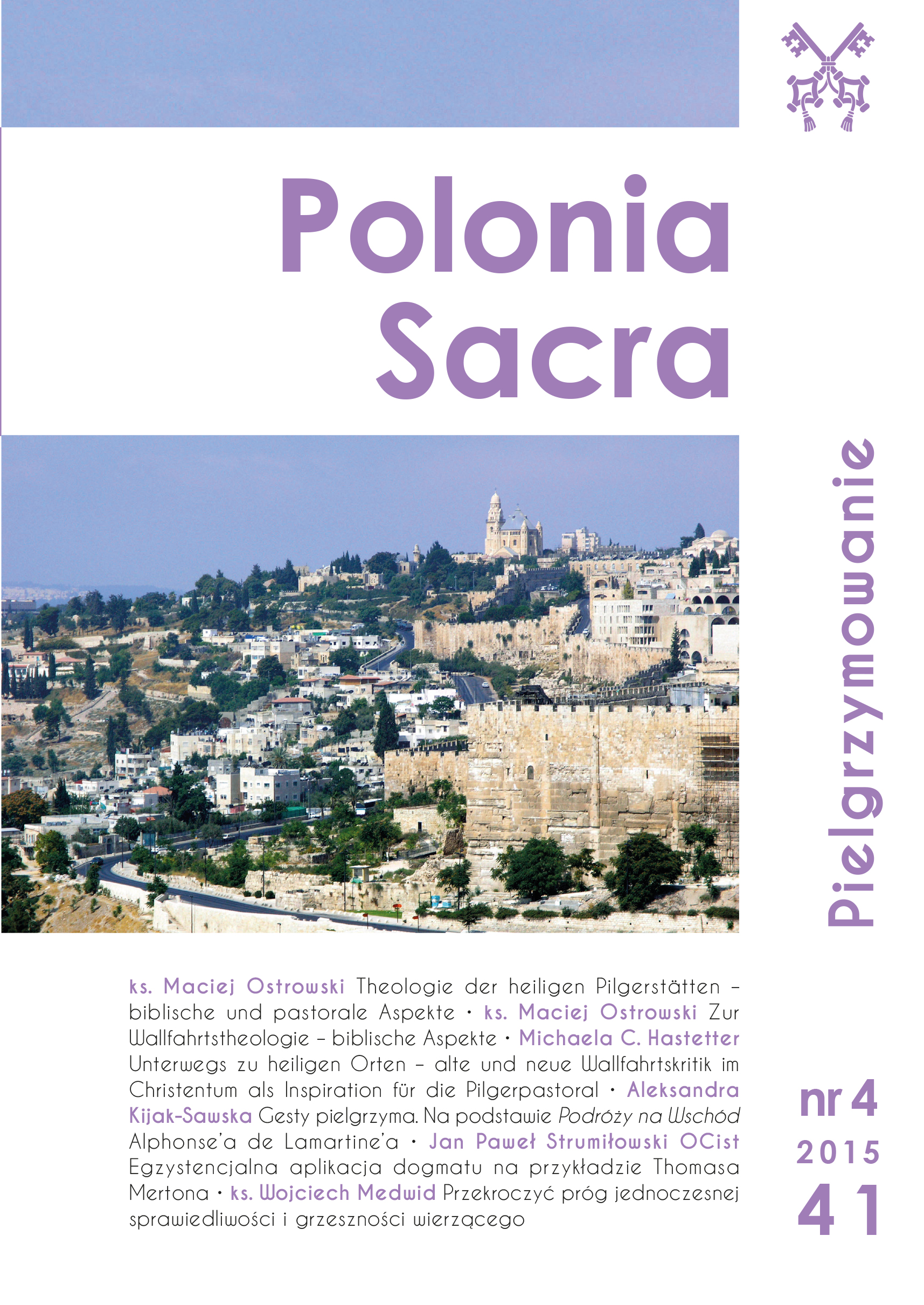Theologie der heiligen Pilgerstätten – biblische und pastorale Aspekte
DOI:
https://doi.org/10.15633/ps.1090Słowa kluczowe:
Heiligtum, Wallfahrt, Theologie, Bibel, WallfahrtseelsorgeAbstrakt
Der Artikel konzentriert sich auf ausgewählte Aspekte der Theologie der Sanktuarien, der Orte, die Ziel christlicher Pilgerfahrten sind. Der Autor stützt sich auf biblische Texte, besonders betreffend das Gelobte Land und die Heilige Stadt Jerusalem mit seinem Tempel, sowie Dokumente des Päpstlichen Rates für die Seelsorge der Migranten und Menschen unterwegs. Jedes irdische Sanktuarium drückt an erster Stelle die Liebe Gottes an den Menschen aus. Gott schafft mit seiner Initiative einen günstigen Platz für ein näheres Treffen mit dem Menschen. Auf der anderen Seite sucht der Mensch selbst einen solchen Platz. Das Sanktuarium ist ein Ort, in dem der Mensch „in Gott ruht” - kommt mit ihm in eine nahe Gemeinschaft. Gleichzeitig kündigt es die künftige Vereinigung mit Gott in Ewigkeit an – „ewige Ruhe in Gott ” nach den Strapazen der irdischen Pilgerfahrt. Dort wird der Mensch die Fülle der Freude und das Glück erreichen. So wie das Gelobte Land und der Tempel von Jerusalem für die Israeliten das Zentrum der Schaffung der Einheit und der Identität des auserwählten Volkes waren, so sind heute Sanktuarien das Werkzeug der Erschaffung und Befestigung der Gemeinschaft der Kirche, an der sich Ankömmlinge aus allen Himmelsrichtungen drängen. Der Artikel unterstreicht, dass die heutigen Sanktuarien nicht nur Orte intensiven Gebets sind, der Blütezeit der Liturgie, sondern auch Zentren der Darbringung von geistigen Opfern, Buße und Bekehrung der Sünder, sowie geistiger Erneuerung eines jeden Pilgers.
Bibliografia
Dec I., Człowiek jako pielgrzym. O pielgrzymowaniu w aspekcie filozoficzno–teologicznym na tle pielgrzymowania do Sanktuarium Matki Bożej Pocieszenia w Leżajsku, „Peregrinus Cracoviensis“ Bd. 7 (1999), S. 61–72.
Majewski M., Mieszkanie Chwały: teologia sanktuarium Izraela na pustyni (Wj 25–31; 35–40), Kraków 2008.
Ostrowski M., Sanktuarium w teologiczno-duszpasterskiej perspektywie, [in:] Zawierzenie Bożemu Miłosierdziu w łagiewnickim sanktuarium. Materiały z sympozjum, Kraków 2003, S. 41–62.
Ostrowski M., Teologia pielgrzymowania, „Polonia Sacra” nr 12, Bd. I/2003, S. 277–294.
Pontifical Council for the Pastoral Care of Migrants and Itinerant People, The shrine a privileged place for a meeting between God and his people, a pilgrim in time, Precedings of the XIV Plenary Meeting 23–25 June 1999, Rome 1999.
Pontificio Consiglio della Pastorale per I Migranti e gli Itineranti, Santuario Nostra Signora di Montserrat, Il Santuario, spazio per un’accgilenza fraterna e universale, Città del Vaticano 2002.
Siudy T., Sanktuaria maryjne w posłudze ewangelizacyjnej Kościoła, [in:] Geografia i sacrum, t. 2, pod red. B. Domańskiego, S. Skiby, Kraków 2005, s. 290–301.
Wolf N., Wohin pilgern wir? Alte Wege und neue Ziele, Reinbek bei Hamburg 2011.
Pobrania
Opublikowane
Numer
Dział
Licencja
Autorzy publikujący w czasopiśmie udzielają jego wydawcy zgody o następującej treści:
- Autor zachowuje autorskie prawa majątkowe do utworu, a jednocześnie udziela wydawcy czasopisma zgody na jego pierwszą publikację w wersji drukowanej i wersji online na licencji Creative Commons Uznanie autorstwa 4.0 Międzynarodowe oraz zgody na wykonywanie opracowań, w tym przekładów.
- Autor ma możliwość udzielania zgody niewyłącznej na opublikowanie utworu w wersji, która ukazała się w czasopiśmie (np. zamieszczenia go w repozytorium instytucjonalnym lub opublikowania w książce), wraz z informacją o jego pierwszej publikacji w czasopiśmie.
- Autor może umieścić swój utwór online (np. w repozytorium instytucjonalnym lub na swojej stronie internetowej) jeszcze przed zgłoszeniem utworu do czasopisma.

